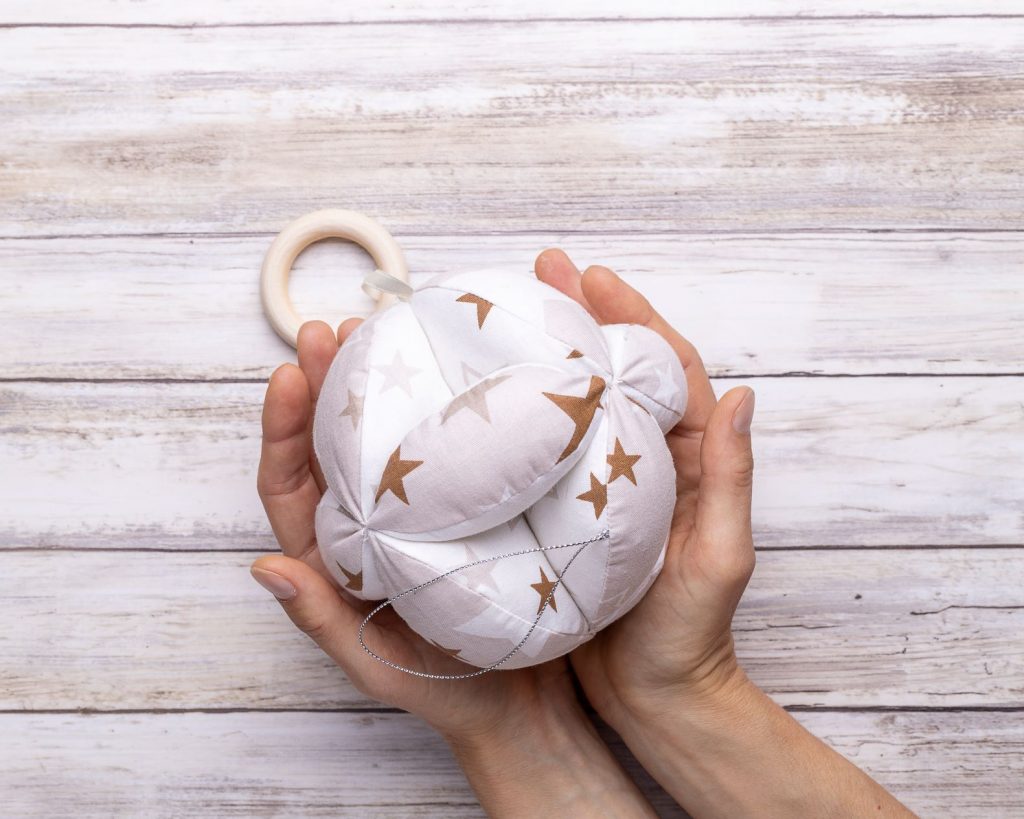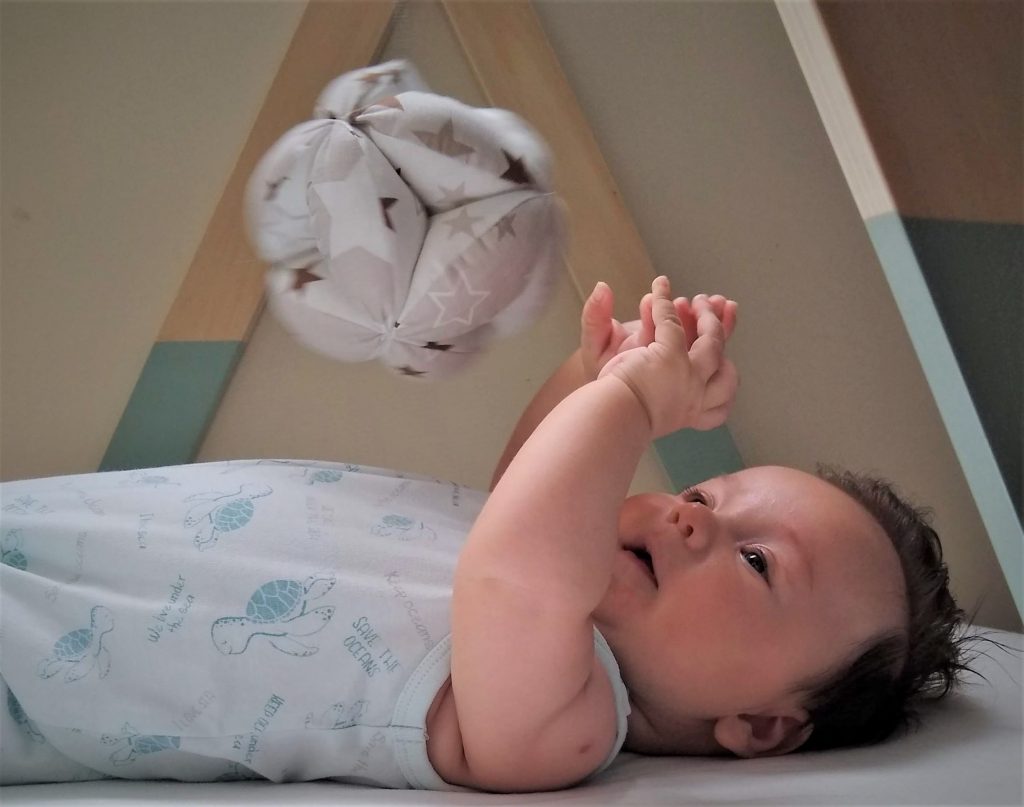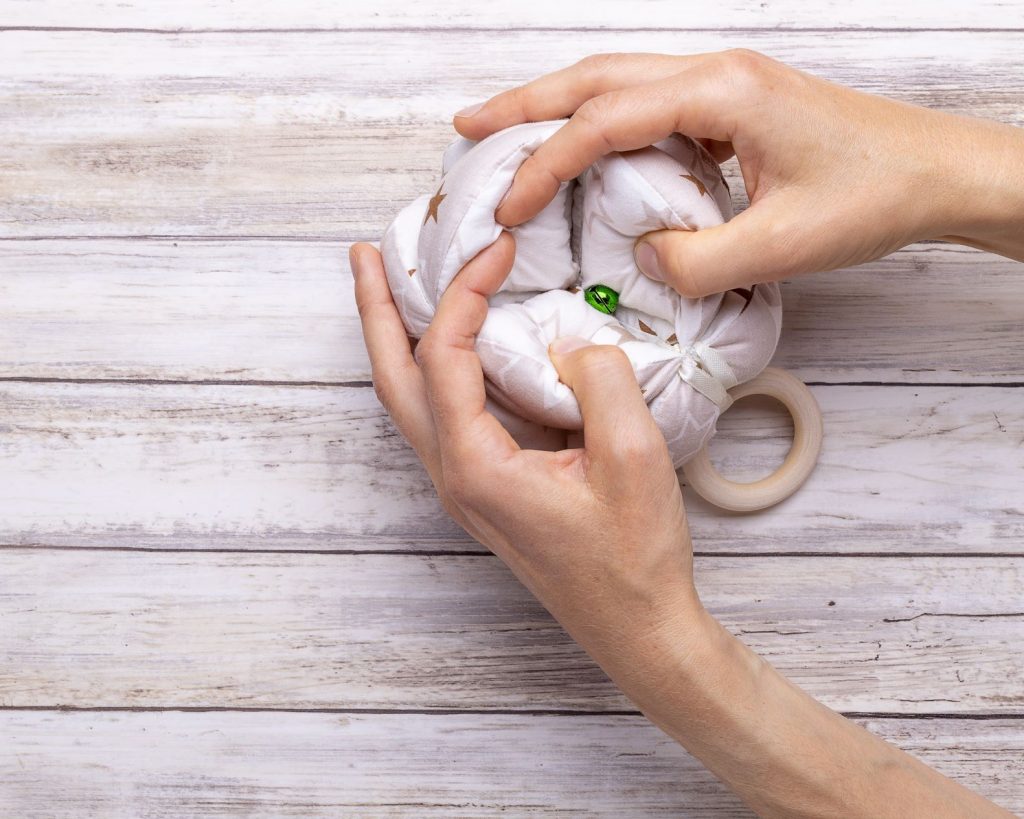One of the most well-known Montessori material for babies is the Montessori Puzzle Ball. It also runs under a variety of names when incognito, such as Takane ball, Amish ball, clutch ball, gripping ball, just to name a few. Just like many other Montessori baby materials, this is also very versatile and ‘grows’ together with your baby, adapting to his/her developmental needs. Not to mention how attractive it is! It’s geometrical, symmetrical and just asking to be grabbed, mouthed and played with! Your baby simply won’t be able to resist interacting with it, with hands, with feet, during tummy time… Read on to learn how to make the most of this little gem!

WHAT DOES IT LOOK LIKE?
The Ball has 12 wedge-shaped sections which are all connected in the middle. You can use any type of material, from leftover fabric scraps to carefully chosen, textured ones. What you should pay attention to is that the inside and the outside fabric should contrast, making it visually appealing for babies.
The wedges are stuffed with filling. In most cases it is poly fill which I am not a fan of! Most probably (scratch that, guaranteed) your baby will put the ball in his/her mouth, drool rivers over it and chew it for hours. I would advise you to try to get one with natural wool filling.
SO WHY IS THE MONTESSORI PUZZLE BALL SO ATTRACTIVE FOR YOUR BABY?
You can introduce this material when your little one is a few weeks old (every baby progresses at a different pace). From that moment on, it will stay around in the following months, even years! The ball can offer a new challenge in every stage of development, stimulating and motivating but without causing frustration. You can start off by using it as a tactile mobile then later use it as an actual ball.
Due to the contrasting colours of the fabric, the Montessori puzzle ball is very attractive to look at. It has beautiful, geometric patterns and its design assures that it’s easy to grasp, pick up and hold.

WHAT ARE THE SCIENTIFIC BENEFITS OF THE PUZZLE BALL?
- Strengthens hand muscles
- Helps to gain finger dexterity and coordination across the body
- Assists in making controlled, voluntary movements in the hands
- Stimulates fine and gross motor skills
- Provides new sensory experiences
- Allows for exploration of the relationship between cause and effect
- Encourages auditory development
- Make purposeful movements and planned actions
- Develop hand-eye coordination
- Open their curiosity towards their surroundings
- They transfer an object from one hand to another
- Passing an object encourages passing the middle line of the body…
- Which in turn stimulates both sides of the brain
- Being able to use it to its purpose raises self-esteem
HOW TO USE THE PUZZLE BALL IN AN AGE-APPROPRIATE WAY
0 – 3 months
- Use the ball as a visual mobile to stimulate visual development by hanging it on a mobile hanger.
3-5 months
- Use the ball as a tactile mobile by lowering it so that your baby can interact with it.
- Hang the ball above your baby’s legs to encourage kicking. If you have a bell attached to the inside or the outside of the ball, it will make a lovely jingling sound, making the experience even more interesting. This also allows your baby to explore the relationship between cause and effect.
5-7 months
- Offer it during tummy time to your baby to reach for, to grab and squeeze.
- Roll the ball in front of your little one so s/he can explore this new movement.
- When your baby learns to sit, give it to her/him so that s/he can explore it from this perspective.
7 months +
- Hide the ball under a blanket. Make sure you leave a bit uncovered. When your baby can ‘find’ the ball like this with confidence, cover more and more of it.
- Play hide and seek with it, making sure a little bit is visible to your baby
- When your baby learns to crawl the ball will be the perfect motivational toy. It rolls but does not roll too far, allowing tiny hands to grasp it easily.

TIPS AND TRICKS
You can keep up your little one’s interest in the Montessori Puzzle Ball by adding extra objects to it, such as a bell, a tag, ribbons or a wooden ring. The possibilities are endless! Tie these objects with a ribbon where the ends of the wedges are connected. Don’t forget, if you tie something to it it won’t roll as well, so make sure that you can take it off later.
Good news, if you know how to sew, then you can DIY the Puzzle Ball! Here‘s a good tutorial for it from petitboutdechou. If you’d like to get the resources with some added extra pieces, take a look at my DIY Puzzle Ball kit in my Shop.
Please always supervise when your baby is playing with a Puzzle Ball to avoid accidents. Check that all the pieces are securely attached, especially if it has extra parts tied to it. Observe your baby and see how s/he improves while using it.
FINAL THOUGHTS
If you are not certain which Montessori material you should get for your baby, I would say get the Montessori Puzzle Ball, without hesitation. Its design makes it perfect for babies to grab, hold and manipulate and it’s light enough that lifting it and passing it from one hand to another won’t be a problem. It’s fun, versatile and will be a favourite of the whole family for months. If you’d like to read about another sewing project for your baby, click on the next post.
Click here to read more about how the Montessori Visual Mobiles, the Montessori Tactile Mobiles or the Sensory Baby Toys help your baby’s development.
How did your baby react to this material? Please share your photos on my Instagram site. #montessoriedited, @montessoriedited
